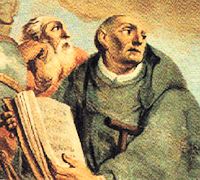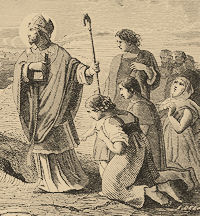Ordinary Time: September 25th
Tuesday of the Twenty-Fifth Week in Ordinary Time
Other Commemorations: St. Finbarr, Bishop (RM); Bl. Herman of Reichenau, Monk (The Cripple) (Hist)
» Enjoy our Liturgical Seasons series of e-books!
Mary, the Mother of God, is our spiritual Mother. The crucifixion was not only the sacrifice for sin, it was also the new birth of mankind to the spiritual life, lost by the sin of Adam. It was the great vital act that completed the work of God in the world. Mary had a share in that work; it was part of her life-work. The Nativity and the Crucifixion were as one action. The sacrifice of the cross began at Bethlehem. The new birth of mankind was completed on Calvary. She was concerned in both, and on each occasion she was present as Mother of the human race. — Excerpted from Our Lady's Feastdays, Rev. Lawrence G. Lovasik, S.V.D.
Meditation for the Month of September: Our Lady of Sorrows
Our Lady did not say to her Son, 'Come down,' but her eyes asked Him to stay there. She knew that the Child who came to her as the world's Savior must save, not Himself, but the world.
I can imagine if you or I had seen Our Lady after the Crucifixion, we should have been astonished at her peace. I think she came down from Calvary consoling Mary Magdalene, and what we do know of her during those terrible days after the death of her Son seems to confirm that. We have just one scene. She is in the Upper Room. An ordinary mother could never have dared to face again that Upper Room where everything reminded her of Him, and of Him in His most poignant moments. Every memory would be a pain, no object of consolation would be there, but a well-spring of sorrow. She is there among a crowd (we are told the very numbers); there is no nursing of her grief away from everyone, but she stayed in the very midst of them all, as if she had to give them consolation. I feel sure many eyes were dried when she came swiftly into their midst. It was almost as if she had never had a Son. They were all her dear children, in the Upper Room. Was there ever a mother that might have been justified in hating mankind, and in brooding over her loss, as if she had a grievance against the world? Yet the one thing about her and her Son is they have no grievance against anyone. She had a memory charged, of course, with ten thousand sorrows and a heart now overloaded with ten thousand loves, but no grievance against the world.
Where did our dear Lady learn this perfect attitude towards suffering? — From her Son. It came of that grace that came to her in the moment of her soul's joy, the grace won for her by the death of her Son foreseen. She learned compassion from Him who had compassion on the multitude.
—Excerpted from Stars of Comfort by Vincent McNabb, O.P.
St. Finbarr (or Finbar)
The patron saint of Cork, was born in Achaid Duborcon near Crookstown, Co. Cork, the son of a Connacht father, a metalworker, who moved to Munster to find work and married a slave girl.
Finbarr left home with three unidentified ascetics and spent much time in Scotland before establishing various hermitages in his native area, notably at Kilclooney and on an island in Gougane Barra, which bears his name.
Among many wondrous tales associated with him is, one in which he is led by an angel from the source of the river Lee at Gougane Barra to its marshy mouth, where he founded his most important monastery, out of which grew the see and the city of Cork. Another of Finbarr's great legends was the chase and expulsion of the great lake serpent from the lake in Gougane, which created the channel that is now the river Lee.
Finbarr died at Cloyne in 633 ad and his remains were taken to Cork to be enclosed in a silver shrine. A pattern is made to Gougane Barra on the Sunday nearest to the feast of St Finbarr which falls on the 25th of September.
Patronage: city of Cork, Ireland; diocese of Cork, Ireland; Barra, Scotland
Highlights and Things to Do:
- Read more about St. Finbarr:
- Celebrating St. Finbarr's Day and the lone Gougane Barra
- See St. Finbarr's Oratory & Island, Gougane Barra, a place of prayer, pilgrimage and peace. Part of Uibh Laoire Parish and the catholic diocese of Cork & Ross.
Blessed Herman of Reichenau
(most often known as Herman the Cripple)
 Herman was born into royalty, the son of a duke of Altshausen. From birth, it was apparent that he would be horribly crippled and disfigured, earning him the less-than-pleasant name of “Hermannus Contractus” (or “Herman the Twisted”). Sources suggest he was born with a cleft palate, cerebral palsy and spina bifida. Without assistance, he could not move, and could barely speak, but within his body was a keen mind and iron will.
Herman was born into royalty, the son of a duke of Altshausen. From birth, it was apparent that he would be horribly crippled and disfigured, earning him the less-than-pleasant name of “Hermannus Contractus” (or “Herman the Twisted”). Sources suggest he was born with a cleft palate, cerebral palsy and spina bifida. Without assistance, he could not move, and could barely speak, but within his body was a keen mind and iron will.
At the age of seven, Herman’s parents left him at the Benedictine monastery of Reichenau, where they arranged for him to be raised and educated. Situated on the shores of Lake Constance, it was expected that this location would be ideal for Herman’s health, but also for his developing intellect. Abbot Berno, the monk who led the community, took Herman under his wing, educating him with kindness and compassion.
Despite his obvious intellect, Herman struggled to read and write at first, his physical limitations difficult to overcome. Once he mastered the basics, the academic world opened to him, and he impressed all with the breadth and depth of his subsequent studies. Not only did he immerse himself in the sciences, but also in languages, music and theology. Herman became fluent in Latin, Greek, and Arabic. He wrote extensively on mathematical and astronomical topics, as well as volumes on the history of the world. He was professed a monk at the age of 30, and continued to write, producing works of great spiritual depth. Of note, his treatise “On the Eight Principal Vices,” which he wrote in a poetic style.
More than his writings, however, Herman was known for his gentleness, joy, and sweet disposition. Never was he heard to complain, despite the fact that most activities were painful and difficult. Rather, he was recognized to have a smile for all, and became a beacon of hope and joy throughout the monastery. Students traveled great distances to study with him, learning not only their academic subjects but also strength of character, perseverance, and humility through his model.
Blessed Herman’s contributions to academics were great, as were his contributions to sacred tradition. He wrote many hymns which continue to be sung today, as well as portions of the Mass. His greatest contributions may be his hymns of devotion and love for Our Blessed Mother: Alma Redemptoris Mater and Salve Regina. The confidence and hope we place in Mary is eloquently and simply captured in his writings.
Blessed Herman died at the young age of 40, having succumbed to the symptoms of his many afflictions. He was beatified in 1863. He was a man who took joy in his struggles, and looked at each difficult day as an opportunity to grow closer to the Lord. Every time we pray the Holy Rosary, we end in prayer with Blessed Herman. The Salve Regina (Hail Holy Queen) reminds us of our deep connection not only to Our Blessed Mother, but to all those who suffer alongside us in the world.
—Excerpted from 365 Rosaries
Highlights and Things to Do:
- Read more about Blessed Hermann:
- Learn the hymns that are attributed to Blessed Hermann: Salve Regina ("Hail Queen"), Veni Sancte Spiritus ("Come Holy Spirit"), and Alma Redemptoris Mater ("Nourishing Mother of the Redeemer").






